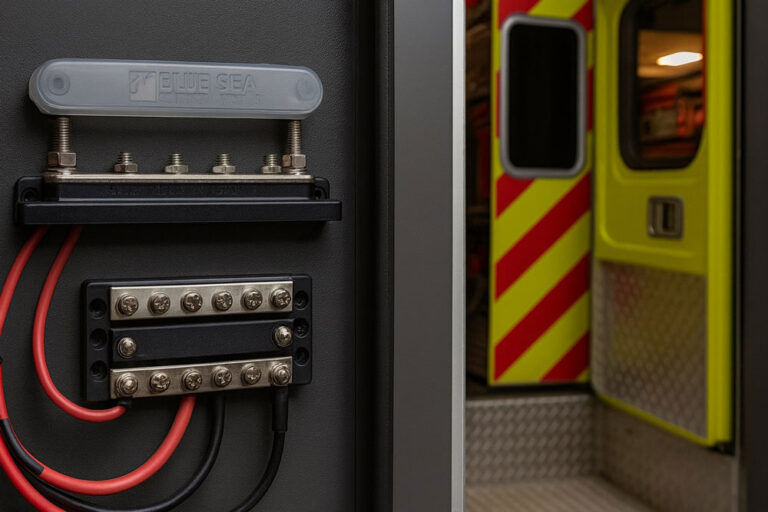Whether you’re outfitting a commercial marine fleet or emergency response vehicles, designing an electrical system that is both reliable and scalable is critical. Traditional point-to-point wiring can become messy, difficult to troubleshoot, and nearly impossible to expand without downtime.
This is where Blue Sea Systems bus bars make a difference. By centralizing power distribution, bus bars simplify wiring, enhance safety, and allow your systems to grow as your operational needs increase. If you’re still weighing your options, you can compare approaches in this guide on Blue Sea Bus Bars vs. Traditional Wiring Methods.
Why Use Blue Sea Bus Bars in Scalable Systems
Centralized Power Distribution
A Blue Sea bus bar acts as a central hub, connecting multiple circuits to a single power source. This setup provides several benefits for commercial and emergency vehicle operators:
- Simplified wiring: Less clutter and fewer individual connections.
- Reduced failure points: Fewer connections mean less chance of loose wires or shorts.
- Easy maintenance: Components can be replaced or upgraded without disturbing other circuits.
Modular Expansion for Growing Systems
One of the biggest advantages of using bus bars is scalability. As your fleet grows or additional equipment is added, bus bars allow you to integrate new circuits without overhauling your system.
- Add lighting, communications, or auxiliary power systems easily.
- Avoid splicing or extending traditional wiring harnesses.
- Maintain a clean, organized layout that meets professional standards.
Improved Safety and Compliance
Blue Sea Systems bus bars are designed with durability and safety in mind:
- High-quality terminals resist vibration and corrosion, essential in marine and mobile applications.
- Proper labeling and color-coded connections reduce installation errors.
- Fusing can be easily integrated to prevent overcurrent and protect both devices and wiring.
Steps to Design a Scalable Electrical System
Step 1 – Assess Power Requirements
- List all devices that will be powered: radios, LED lighting, refrigeration, GPS, USB hubs, emergency gear.
- Determine peak amperage for each circuit.
- Include future expansions to ensure the bus bar can accommodate growth.
Step 2 – Select the Right Blue Sea Bus Bar
- Choose bus bars rated for your system’s voltage and current requirements.
- Consider positive and negative bus bars to centralize both supply and return paths.
- Look for models with removable terminal covers for easy maintenance.
Step 3 – Plan Your Wiring Layout
- Route wires from each device to the bus bar using appropriately sized conductors.
- Group circuits logically: lighting, communications, auxiliary power, emergency equipment.
- Maintain short, direct runs to minimize voltage drop and maximize efficiency.
Step 4 – Integrate Fuse Protection
- Fuse each circuit at the bus bar or close to the power source.
- Use the correct fuse rating for each device to prevent damage or fire hazards.
- Label each fused connection clearly for quick identification during service.
Step 5 – Test and Document
- Test each circuit individually before putting the system into full operation.
- Document your layout, including wire sizes, device connections, and fuse ratings.
- Keep this documentation for maintenance, audits, and future expansions.
Real-World Applications
Emergency Vehicles
- Bus bars simplify adding radios, lighting, and medical equipment.
- Technicians can replace or add circuits quickly during fleet maintenance.
- Centralized fusing ensures safe operation under high-demand conditions.
Commercial Marine Vessels
- Integrates navigation, lighting, and auxiliary systems cleanly.
- Reduces wiring clutter and simplifies troubleshooting during dockside inspections.
- Easily accommodates new electronics or communications systems as they’re added.
Conclusion
Using Blue Sea Systems bus bars is a professional, reliable solution for designing scalable electrical systems in marine and emergency vehicles. By centralizing power distribution, you can:
- Simplify wiring and reduce failures
- Scale your system as needs grow
- Improve safety and serviceability
A well-planned bus bar system is not just an upgrade—it’s a foundation for efficient, future-proof mobile power systems.

0 Comments